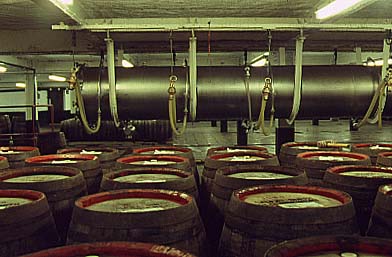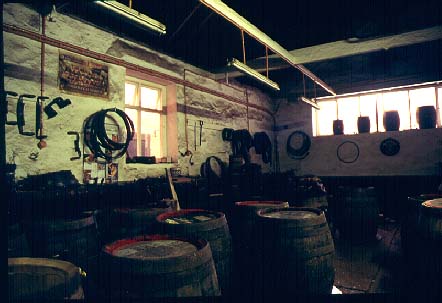Samuel Smith's Brewery Tour - Page 6

Here's where they fill the casks with the beer. They are called "racking
stations" and their are six of them, although you can only see
four in this photo. This was Friday (cleanup day) so the brewery was much
quieter than usual. The way that the racking stations work is that they
not only fill the casks with beer, but also they accept the fob (foam)
that is created during filling. The horizontal cylinder in this picture
is where the fob settles back into beer.
One thing I didn't show here are "settling tanks" which
is where the beer is stored for a few days after fermentation in the stone
squares, prior to racking in to casks. In addition to putting beer in the
casks, this is where they also add priming sugar and isinglass finings.
The priming sugar gives the yeast a measured amount of food and results
in them making a measured amount of additional carbon dioxide for carbonation.
While Cask-Conditioned Real Ale contains less carbonation than American
Lagers, the beer is not really warm and flat as many have said in the past.
The proper serving temperature for most ales is 50 to 55F (the proper serving
temperature for lagers being 45 to 50F, although many bars serve it much
colder). The isinglass is added to speed the settling of the yeast when
it finally reaches the pub and to make the yeast pack more firmly in the
belly of the cask.

This is the Coopers' Shop. It is where all the casks are built and repaired.
There are four full-time coopers on staff at The Old Brewery. The casks
are made in several sizes from european oak. No nails, glue, screws or
sealants are used. The seal between the head of the cask and the staves
is sealed with dried rushes which expand when wet.
Back to Page 5 |
Next Page on the Tour
Back To
the BrewInfo Page (Home)
Copyright © 1997 Al Korzonas - All Rights Reserved

